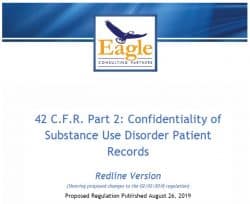Proposed Changes to 42 CFR Part 2 Will Affect Community Health Centers and Other Clinics
In response to the opioid crisis, the medical community has increased its efforts to offer solutions. With encouragement from the federal Substance Abuse and Mental Health Services Administration (SAMHSA), access to medication-assisted treatments is increasing. More medical settings are offering this treatment, including primary care offered by hospital-based practices, Rural Health Clinics, and urban Community Health Centers. As these settings increase their services for substance abuse, more are subject to the federal Confidentiality of Substance Use Disorder Patient Records, also known as 42 CFR Part 2.
Click HERE to download your free copy of Eagle Consulting Partners’ exclusive redlined version of the proposed changes to 42 CFR Part 2!
In August of 2019, SAMHSA released proposed changes to 42 CFR Part 2. A redlined version of this regulation, showing the proposed changes, was prepared by Eagle Consulting Partners and is available for download. The intent of the changes was to promote value-based outcomes for patients to remove barriers to coordinated care among providers. However, lacking legislation from Congress to relax the original statute, the administration was limited in what it could accomplish through its authority alone.
Are You Subject to the Regulations?
Organizations providing medication assisted treatments should evaluate whether their organization, or a clinician/unit of their organization, is subject to the regulations.
The 42 CFR Part 2 regulations apply to a “program”, which is an individual or entity which
- receives federal assistance, for example, reimbursement from Medicare or Medicaid
- “holds itself out as providing, and provides, alcohol or drug abuse diagnosis, treatment, or referral for treatment”
A more detailed description of applicability is available in FAQs provided by SAMHSA.
As settings such as Community Health Centers begin advertising their Substance Use Disorder treatments, for example, on their websites, they “hold themselves out as providing” these treatments, and consequently become subject to the 42 CFR Part 2.
Many primary care and certain specialty care practices are not advertising this service, but employ one or more clinicians who are trained to offer buprenorphine (Suboxone) and/or naltrexone (Vivitrol). Guidance from SAMHSA suggests that if a clinic is not advertising these services, a clinician becomes subject to these regulations only if their prescribing/monitoring exceeds 50% of their patients treated.
Eagle Consulting Partners offers support to organizations who must comply with these regulations. Support can include…
- Preparing a Gap Analysis to identify areas where the organization’s existing HIPAA policies and procedures must be adjusted for compliance with the regulations
- Performing remediation to update policies for full compliance
- Assisting with implementation of the new policies, including adjustments to information systems, contracting changes, and staff training
Coordination of Care
The Department of Health and Human Services (HHS) released the long-awaited proposed changes to the rule that was originally meant to protect those with addiction disorders from facing legal and civil consequences if they sought treatment. However, 42 CFR Part 2 was overly stringent when it came to patient confidentiality… providers could not share records that pertained to substance abuse, even with the patient’s written consent. This made coordination of care unnecessarily difficult.
 Do No Harm
Do No Harm
Attorneys General across the country have been urging congress to align the privacy regulations that surround substance abuse with the privacy regulations found in HIPAA, making coordination of care easier for those seeking treatment for opioid use disorders. In a letter to Congress, they wrote
“while maintaining confidentiality is imperative to encouraging individuals to seek and obtain treatment, the inability to share records among providers can burden coordination of care, potentially resulting in harm to the patient.”
Many primary care providers have been discouraged from prescribing opioids or other drugs that can interact with opioids because up until now there has been no way to verify in a central database whether a patient was already receiving treatment for opioid use disorders. These proposed changes will allow this essential sharing of patient record information.
Addressing the Opioid Epidemic and Mental Health
The proposed change in 42 CFR Part 2 is the first step in HHS’s “Regulatory Sprint to Coordinated Care,” which is an ongoing effort designed to move health from volume-based care to value-based care. The proposed change looks to address the ongoing opioid crisis, as well as obstacles to behavioral and mental health care, as it seeks to make coordination of care the standard.



 Do No Harm
Do No Harm